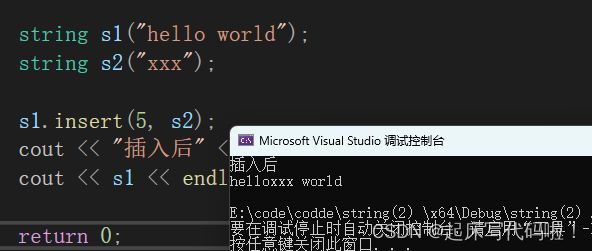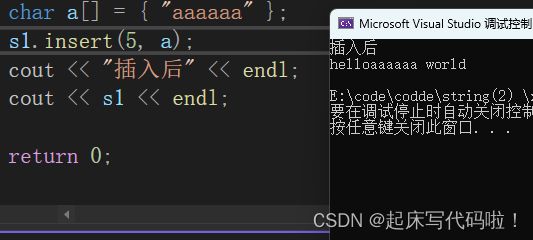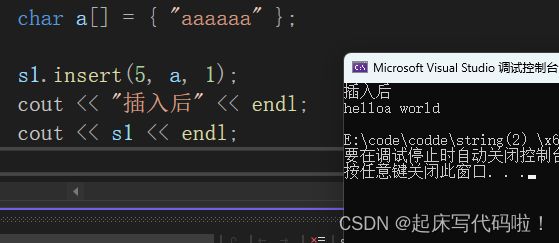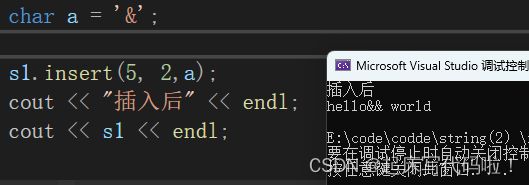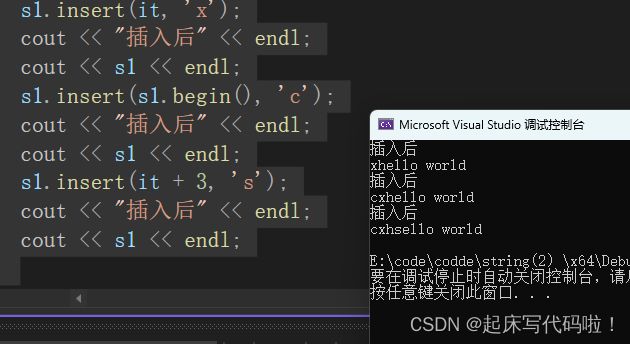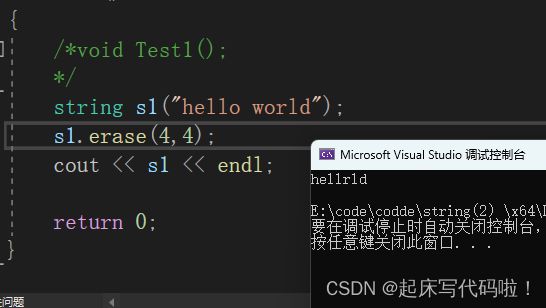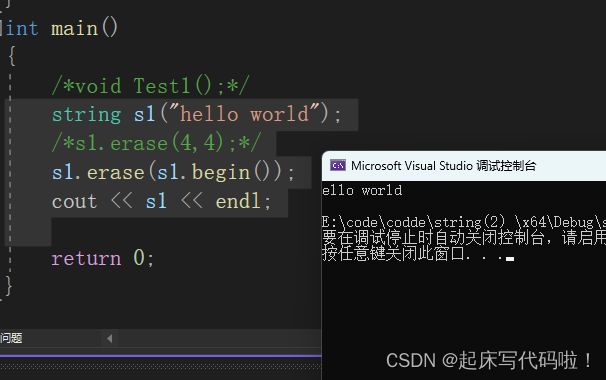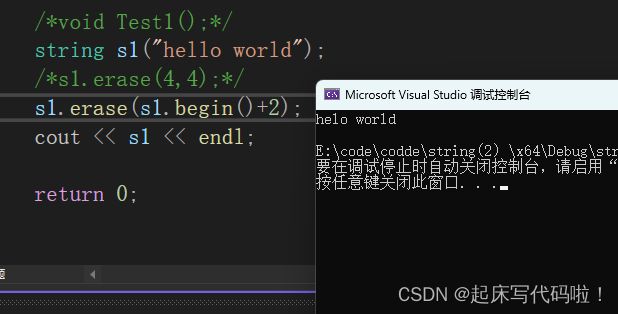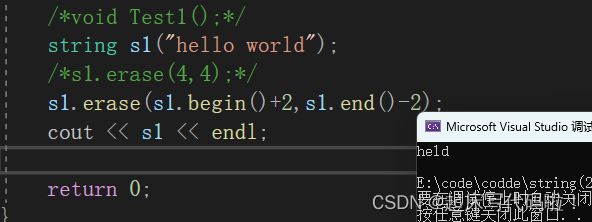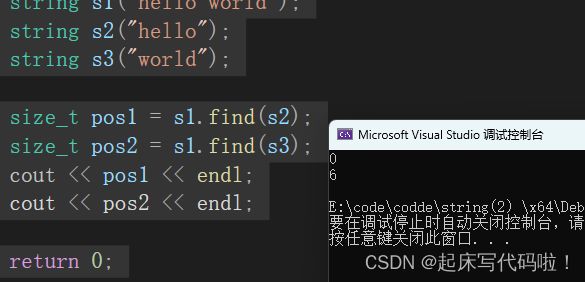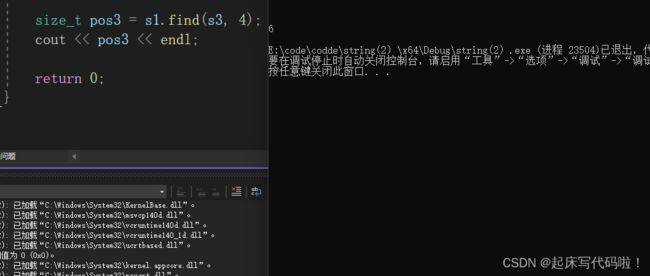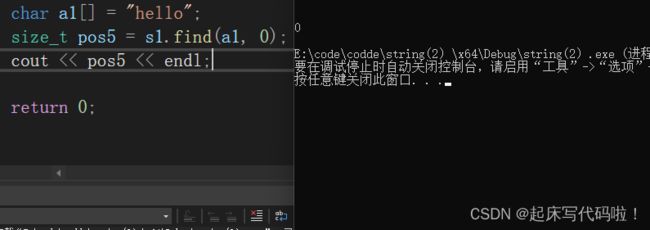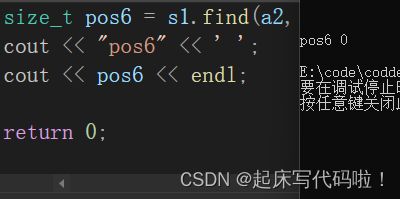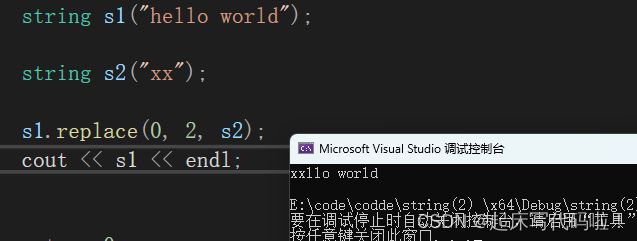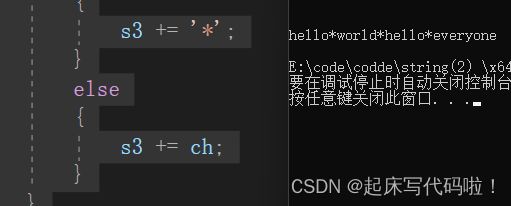C++(12)——string
目录
1.insert:
1.1 string& insert (size_t pos, const string& str):
1.2 string& insert (size_t pos, const char* s):
1.3 string& insert (size_t pos, const char* s, size_t n):
1.4 string& insert (size_t pos, size_t n, char c):
1.5 iterator insert (iterator p, char c):
2. erase:
2.1 string& erase (size_t pos = 0, size_t len = npos):
2.2 iterator erase (iterator p):
2.3 iterator erase (iterator first, iterator last):
3. find:
3.1 size_t find (const string& str, size_t pos = 0) const:
3.2 size_t find (const char* s, size_t pos = 0) const:
3.3 size_t find (const char* s, size_t pos, size_t n) const:
3.4 size_t find (char c, size_t pos = 0) const:
4. replace:
4.1 string& replace (size_t pos, size_t len, const string& str):
上篇文章中,介绍了![]() 中一些函数的应用。本篇文章将介绍其他
中一些函数的应用。本篇文章将介绍其他![]() 中相关函数的应用。
中相关函数的应用。
1.insert:
string& insert (size_t pos, const string& str);
string& insert (size_t pos, const char* s);
string& insert (size_t pos, const char* s, size_t n);
string& insert (size_t pos, size_t n, char c);
iterator insert (iterator p, char c);
1.1 string& insert (size_t pos, const string& str):
对于本部分标题中的函数,其作用为在已有![]() 类型的对象的第
类型的对象的第![]() 个位置插入另一个
个位置插入另一个![]() 类型的对象,具体方法如下:
类型的对象,具体方法如下:
int main()
{
string s1("hello world");
string s2("xxx");
s1.insert(5, s2);
cout << "插入后" << endl;
cout << s1 << endl;
return 0;
}运行结果如下:
1.2 string& insert (size_t pos, const char* s):
对于本部分标题中的函数,其作用为在已有![]() 类型的对象的第
类型的对象的第![]() 个位置插入一个常量字符串,具体使用方法如下:
个位置插入一个常量字符串,具体使用方法如下:
string s1("hello world");
char a[] = { "aaaaaa" };
s1.insert(5, a);
cout << "插入后" << endl;
cout << s1 << endl;1.3 string& insert (size_t pos, const char* s, size_t n):
对于本部分标题中的函数,其作用为在已有![]() 类型的对象的第
类型的对象的第![]() 个位置插入另一个另一个常量字符串的前
个位置插入另一个另一个常量字符串的前![]() 个字符,具体使用方法如下:
个字符,具体使用方法如下:
string s1("hello world");
char a[] = { "aaaaaa" };
s1.insert(5, a, 1);
cout << "插入后" << endl;
cout << s1 << endl;1.4 string& insert (size_t pos, size_t n, char c):
对于本部分标题中的函数,其作用为在已有![]() 类型的对象的第
类型的对象的第![]() 个位置插入
个位置插入![]() 个连续的字符。例如在一个
个连续的字符。例如在一个![]() 类型的对象的第
类型的对象的第![]() 个位置插入两个连续的字符&:
个位置插入两个连续的字符&:
string s1("hello world");
char a = '&';
s1.insert(5, 2,a);
cout << "插入后" << endl;
cout << s1 << endl;运行结果如下:
此外,本函数经常用做在![]() 类型对象中进行头插,例如:
类型对象中进行头插,例如:
string s1("hello world");
char a = '&';
s1.insert(0,1,a);
cout << "插入后" << endl;
cout << s1 << endl;运行结果如下:
1.5 iterator insert (iterator p, char c):
对于本部分标题中的函数,其作用为通过迭代器来向![]() 类型的对象中插入字符,例如:
类型的对象中插入字符,例如:
string::iterator it = s1.begin();
s1.insert(it, 'x');
cout << "插入后" << endl;
cout << s1 << endl;
s1.insert(s1.begin(), 'c');
cout << "插入后" << endl;
cout << s1 << endl;
s1.insert(it + 3, 's');
cout << "插入后" << endl;
cout << s1 << endl;
运行结果如下:
2. erase:
string& erase (size_t pos = 0, size_t len = npos);
iterator erase (iterator p);
iterator erase (iterator first, iterator last);2.1 string& erase (size_t pos = 0, size_t len = npos):
对于函数![]() ,其功能是对已有的
,其功能是对已有的![]() 类型的对象中的内容进行删除。对于本标题中的函数,其中的两个参数均有缺省值,对于第一个参数,即:
类型的对象中的内容进行删除。对于本标题中的函数,其中的两个参数均有缺省值,对于第一个参数,即:
size_t pos = 0意义为:如果不认为给定参数,则默认从对象的开头进行删除。
对于第二个参数,即:
size_t len = npos其意义为:删除对象中内容的长度。如果不人为给定参数,则默认删除到![]() ,对于
,对于![]() ,是一个常数,大小为
,是一个常数,大小为![]() ,在本部分可以理解为:如果没有给定参数,则直接删除对象中的所有内容。
,在本部分可以理解为:如果没有给定参数,则直接删除对象中的所有内容。
对于不给参数调用![]() ,即:
,即:
int main()
{
string s1("hello world");
s1.erase();
cout << s1 << endl;
return 0;
}运行结果为:
假如指定从对象的第![]() 个字符,即下标为
个字符,即下标为![]() 开始删除一直到最后,即:
开始删除一直到最后,即:
int main()
{
/*void Test1();
*/
string s1("hello world");
s1.erase(4);
cout << s1 << endl;
return 0;
}运行结果为:
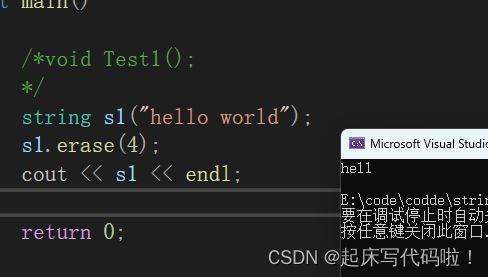
假设指定从对象的第![]() 个字符开始,删除到对象的第
个字符开始,删除到对象的第![]() 个字符,即删除内容的长度为
个字符,即删除内容的长度为![]() :
:
2.2 iterator erase (iterator p):
本部分标题给出的函数主要是让![]() 与迭代器进行结合,函数的参数只有一个,本函数的意义为:删除迭代器位置的字符。例如:
与迭代器进行结合,函数的参数只有一个,本函数的意义为:删除迭代器位置的字符。例如:
string s1("hello world");
s1.erase(s1.begin());
cout << s1 << endl;
运行结果如下:
如果想删除对象中的第三个字符,也就是下标为![]() 的位置的字符,即:
的位置的字符,即:
string s1("hello world");
s1.erase(s1.begin()+2);
cout << s1 << endl;2.3 iterator erase (iterator first, iterator last):
对于本部分标题中的函数的参数与上一个函数相同,但是本函数是删除![]() 这个区间的字符,例如:
这个区间的字符,例如:
string s1("hello world");
s1.erase(s1.begin()+2,s1.end()-2);
cout << s1 << endl;运行结果如下:
3. find:
size_t find (const string& str, size_t pos = 0) const;
size_t find (const char* s, size_t pos = 0) const;
size_t find (const char* s, size_t pos, size_t n) const;
size_t find (char c, size_t pos = 0) const;3.1 size_t find (const string& str, size_t pos = 0) const:
对于本部分标题中的函数,其大致意义为:给定一个![]() 类型的对象
类型的对象![]() ,在已有的
,在已有的![]() 类型的对象中去查找
类型的对象中去查找![]() ,如果找到了,返回
,如果找到了,返回![]() 在已有
在已有![]() 类型的对象的下标,如果找不到则返回
类型的对象的下标,如果找不到则返回![]() 。
。
对于函数的第![]() 个参数,如果不给定具体参数,则按照缺省参数从已有对象的值,从
个参数,如果不给定具体参数,则按照缺省参数从已有对象的值,从![]() 位置开始查找。具体使用如下:
位置开始查找。具体使用如下:
int main()
{
string s1("hello world");
string s2("hello");
string s3("world");
size_t pos1 = s1.find(s2);
size_t pos2 = s1.find(s3);
cout << pos1 << endl;
cout << pos2 << endl;
return 0;
}运行结果如下:
对于两个参数的使用,例如从下标为![]() 的位置开始进行查找,即:
的位置开始进行查找,即:
string s1("hello world");
string s3("world");
size_t pos3 = s1.find(s3, 4);
cout << pos3 << endl;当不能查找到相应的内容时,例如:
string s1("hello world");
string s2("hello");
size_t pos3 = s1.find(s2,6);
cout << pos3 << endl;3.2 size_t find (const char* s, size_t pos = 0) const:
具体使用方法与![]() 中相同,只是参数有改变,本部分只给出一个应用,其他不再进行叙述:
中相同,只是参数有改变,本部分只给出一个应用,其他不再进行叙述:
char a1[] = "hello";
size_t pos5 = s1.find(a1, 0);
cout << pos5 << endl;运行结果如下:
3.3 size_t find (const char* s, size_t pos, size_t n) const:
本标题中函数的大致意思为:在已有的![]() 类型的第
类型的第![]() 位置,查找字符串
位置,查找字符串![]() 的前
的前![]() 个字符,例如:
个字符,例如:
char a2[] = "helloyou";
size_t pos6 = s1.find(a2, 0, 5);
cout << pos6 << endl;运行结果如下:
对于上面的字符串![]() ,如果是在已有的
,如果是在已有的![]() 类型的对象中寻找前
类型的对象中寻找前![]() 个字符,即在
个字符,即在![]() 中寻找
中寻找![]() ,即:
,即:
size_t pos6 = s1.find(a2, 0, 6);
cout << "pos6" << ' ';
cout << pos6 << endl;运行结果为:
由于找不到匹配的内容,因此返回![]() 。
。
3.4 size_t find (char c, size_t pos = 0) const:
本部分标题中函数的大致意义为:从已有的![]() 类型的
类型的![]() 位置开始寻找一个字符
位置开始寻找一个字符![]() ,如果不人为给定
,如果不人为给定![]() 的值,则默认从开头进行查找,具体使用方法如下:
的值,则默认从开头进行查找,具体使用方法如下:
string s6("abcdefg");
size_t pos7 = s6.find('a');
size_t pos8 = s6.find('a', 1);
cout << "pos7:" << pos7 << endl << "pos8:" << pos8 << endl;运行结果如下:
4. replace:
string& replace (size_t pos, size_t len, const string& str);
string& replace (iterator i1, iterator i2, const string& str);
string& replace (size_t pos, size_t len, const string& str,
size_t subpos, size_t sublen);
string& replace (size_t pos, size_t len, const char* s);
string& replace (iterator i1, iterator i2, const char* s);
string& replace (size_t pos, size_t len, const char* s, size_t n);
string& replace (iterator i1, iterator i2, const char* s, size_t n);
由于![]() 的设计中,相似的部分过多,因此,文章只给出其中一个函数的使用
的设计中,相似的部分过多,因此,文章只给出其中一个函数的使用
4.1 string& replace (size_t pos, size_t len, const string& str):
本部分标题函数的大致意义为:从已有![]() 对象的
对象的![]() 位置开始,把相隔
位置开始,把相隔![]() 个字符位置之内的内容,也就是
个字符位置之内的内容,也就是![]() 替换成
替换成![]() 。
。
具体使用方法如下:
string s1("hello world");
string s2("xx");
s1.replace(0, 2, s2);
cout << s1 << endl;对于不同的场景,可以结合上方的函数来解决不同的问题,例如:
将![]() 中的空格全部替换为
中的空格全部替换为![]() :
:
string s2("hello world hello everyone");
size_t pos = s2.find(' ');
while (pos != s2.npos)
{
s2.replace(pos,1, "*");
pos = s2.find(' ');
}
cout << s2 << endl;运行结果如下:
但是这种方法每次循环都要从头去找空格所在的位置,并且![]() 函数本身的作用原理就类似顺序表中的头插,效率过低,因此采用下面的方法:
函数本身的作用原理就类似顺序表中的头插,效率过低,因此采用下面的方法:
string s4("hello world hello everyone");
string s3;
for (auto ch: s4)
{
if (ch == ' ')
{
s3 += '*';
}
else
{
s3 += ch;
}
}
cout << s3 << endl;
运行结果如下:
